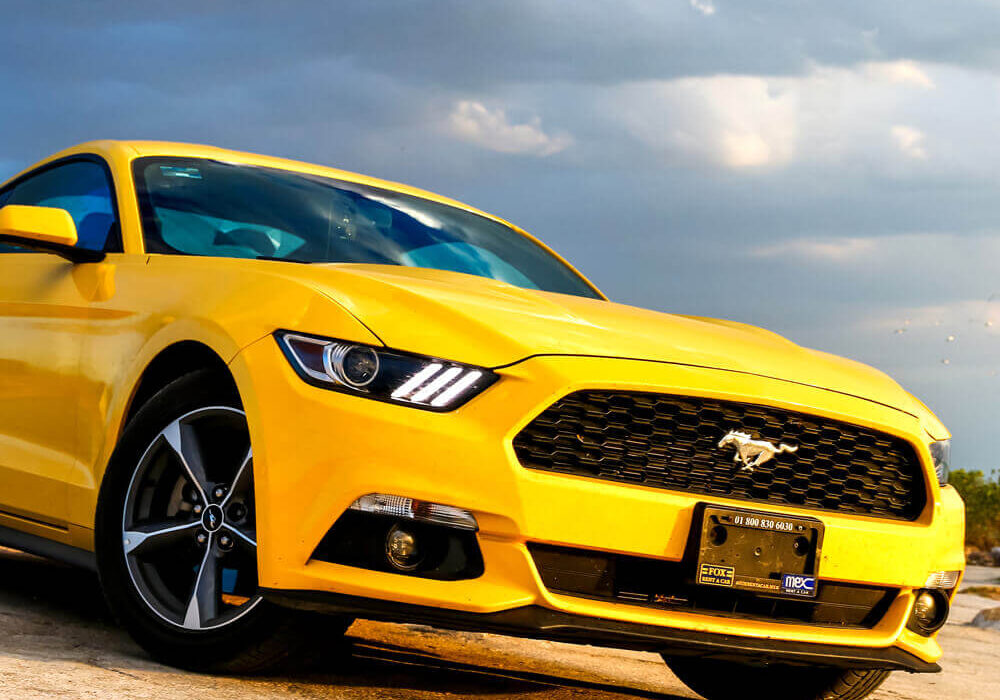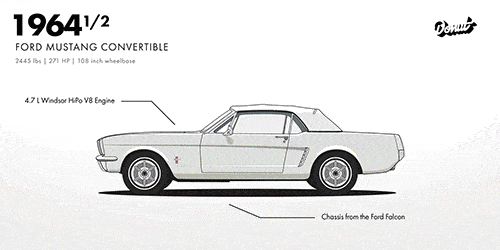Ford Mustang Evolution: A Legacy of American Muscle and Performance
Ford produced one of the most iconic vehicles in automotive history in record time and on a shoestring budget.
Updated: November 14, 2023 // Car Evolutions

Home // Car Evolutions //
The allure of Ford's Mustang, an iconic embodiment of American automotive prowess, has bewitched enthusiasts worldwide since its inception in the swinging sixties. The Mustang gallops ahead of the herd as a muscular icon that skillfully mixes power, handling, and value, always breaking new ground with ceaseless improvements.

1st Generation Mustang (1964-1973)
Born amidst the effervescent energy of the early 1960s, the Mustang swiftly ascended to the pantheon of automotive greats, creating a new niche in the market known as "pony cars".
The first generation Mustang, also known as the "1964½" model, was introduced to the public on April 17, 1964. Taking its roots from the compact Ford Falcon, the first-gen Mustang rocked a snazzy, small-sized design sporting an elongated hood and abbreviated rear. Whether you preferred a coupe or convertible, the first-gen Mustang had your back, offering engines like the 170 cubic inch inline-six and the beefy 260 cubic inch V8. Nicknamed the "Pony Car," this generation of Mustang set the standard for the sporty, compact design that would become a trademark of the Mustang. In the muscle car showdown, Mustang held its ground, squaring off against tough competitors like Camaro from Chevy, Barracuda from Plymouth and Javelin by AMC.
The Mustang went from a sporty little number to an absolute beast. An array of diverse engine options graced each iteration, exemplifying Ford's relentless pursuit of performance refinement. This relentless innovation empowered Mustang's consistent growth in size and power, pushing the boundaries of what a pony car could be.

2nd Generation Mustang (1974-1978)
The second generation Mustang, also known as the "Mustang II," was a significant departure from the first generation model. Though it was more compact, lighter and better on gas, the Mustang II sacrificed a bit of its muscle and lost some of its sports car vibe. When it came to picking an engine, you were faced with two choices: a smaller, compact 2.3-liter four-cylinder for efficiency or a robust 2.8-liter V6 if power was your priority. You could either go for a smaller, zippy 2.3-liter four-cylinder engine or ramp it up with the brawnier 2.8-liter V6 for that added oomph in your Mustang II. You had the choice between a smaller, compact 2.3-liter four-cylinder engine or stepping up to a meatier 2.8-liter V6 for your Mustang II.

Image from zero260
3rd Generation Mustang (1979-1993)
Fast forward to 1979, the Mustang roared back with a new lifeblood: the Fox platform. When it rolled out, this car's versatility went through the roof - it gave us a whole menu of engines to pick from, so drivers could find their perfect match. This strategic move proved instrumental, bolstering the Mustang's position as a versatile performance car and propelling it to new heights of popularity.
The third generation Mustang, also known as the "Fox Body" Mustang, was a return to the sporty design of the first generation model. The Fox Body Mustang packed some serious muscle under the hood compared to the underpowered Mustang II. When it came to powertrain options, you were spoilt for choice with three potent engines: You've got three zippy engines to choose from: the lively 2.3-liter four-cylinder, the balanced 2.8-liter V6, or take a ride on the wild side with the beastly 5.0-liter V8. You have the option to pick the agile 2.3-liter four-cylinder, opt for the well-rounded 2.8-liter V6, or rule the road with the monstrous 5.0-liter V8. It competed with the Pontiac Firebird and Buick Grand National.

4th Generation Mustang (1994-2004)
The fourth generation Mustang, also known as the "SN-95" Mustang, featured a more rounded, aerodynamic design and a variety of engine options. The basic Mustang was packing a 3.8-liter V6, but the GT version stepped it up with a beefier 4.6-liter V8 engine under its belt. In this era, Ford launched the Mustang SVT Cobra - a souped-up Mustang variant sporting a robust 4.6-liter V8 powerhouse under its hood. The SVT Cobra became one of the most popular Mustangs of all time. Against competitors like the Chevy Camaro, Pontiac Firebird, and even the mighty Dodge Viper, it didn't flinch an inch.

5th Generation Mustang (2005-2014)
The fifth generation Mustang, also known as the "S-197" Mustang, featured a more retro design inspired by the first generation model. This model seriously upped its game, totally eclipsing the previous version with beefier 4.0-liter V6 and 4.6-liter V8 engines crammed under the hood. With this generation, we saw the birth of the Ford Mustang Shelby GT500 - a beast with a supercharged 5.4-liter V8 engine taking performance to new heights. The Mustang GT500 competed with the Chevy Camaro, Dodge Challenger, and Dodge Charger as rivals in the muscle car segment.

6th Generation Mustang (2015-2022)
The sixth generation Mustang, also known as the "S550" Mustang, featured an all-new design and an updated powertrain. The basic version came with a 3.7-liter V6 motor, but if you wanted more power, the GT model packed a punch with its hefty 5.0-liter V8 engine. In this period, Ford also rolled out the adrenaline-pumping Shelby GT350 and GT350R Mustang models, both equipped with a potent 5.2-liter V8 engine. This Mustang era really hit it out of the park with its power, tech, and handling - truly one of the most decked-out 'Stangs ever made.
7th Generation Mustang (2023-Current)
Today, the Mustang stands proudly as a paragon of reliable performance. But the Mustang keeps selling like hotcakes because it hits the sweet spot between being affordable yet still plenty fast. The seventh generation Mustang, also known as the "S650" Mustang, features a more aerodynamic design and new technology. The standard Mustang packs a 2.3-liter EcoBoost 4-cylinder engine, but if you opt for the GT version, you're getting a beefy 5.0-liter V8 under the hood. Additionally, you've got the option to rev up a Shelby GT500 in this line-up, boasting a beefy 5.2-liter supercharged V8 under its hood.
To quote Carroll Shelby, "I've always been asked, 'What is my favorite car?' and I've always said, 'The next one.'" We believe the Mustang, in its continual quest for perfection, echoes this sentiment perfectly.

Image source: Road and Track
Ford Mustang FAQs
Ford aimed for the Mustang to be a budget-friendly powerhouse, consistently keeping prices low even if it meant using old-school tech like live rear axles. Mustangs sold well, so there is always a significant supply on the used market, keeping costs low.
What is the lowest-priced new Mustang? Before you add upgrades, the base Mustang normally costs roughly $28,000.
Yes, and it has (nearly) always been. The Mustang has been a reliable grin-generator since its launch in 1964, with the exception of the Mustang II, which was focused on economy. Though craftsmanship was not historically a strong attribute for Ford, Mustangs are generally well-built vehicles that bring large smiles.
Though modern Ford Mustangs have a slew of active safety measures, higher-end models have a mix of high horsepower and rear-wheel drive that may make them a handful in wet or snowy weather—and "dangerous" in the hands of inexperienced young drivers. Unfortunately, their low price makes them accessible to younger drivers, hence they have a higher crash rate than other vehicles.
Ford claimed a top speed of 200 mph for the 662-hp 2013 Shelby GT500, however it would take a long way to get there. The 2020 Shelby GT500 has 100 horsepower more, so it should be faster in theory—but Ford electronically limited its top speed at 180 mph. The top speed of most other high-performance Mustangs is 155 mph.
For sure, that's spot on. Apart from the occasional oil change, today's Mustangs don't need much upkeep. Because there are so many older Mustangs around, it's easy to find replacement parts and mechanics who know how to work on them.
Disclaimer: The writers of this article may have used artificial intelligence to help them with some of the material. It should not be a replacement for professional help.
Sources:
- Mustang Evolution Forum. (n.d.). Mustang Evolution Forum. https://www.mustangevolution.com/
- Watch How the Ford Mustang Evolved Over 50-Plus Years. (2017, November 6). Road & Track. https://www.roadandtrack.com/car-culture/classic-cars/a13435709/watch-how-the-ford-mustang-evolved-over-50-plus-years/
- 1964-2024 │ 60 Years of Ford Mustang Evolution. (n.d.). SSTubes. https://www.sstubes.com/blogs/news/1964-2024-ford-mustang-evolution







